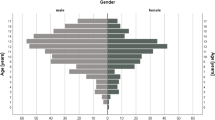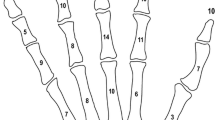Abstract
Background
Fractures of the hand are common, with an annual incidence of 3–4 per 1,000 population. These injuries have the potential for significant complications which can be devastating for the young working population in which they predominantly occur.
Methods
This study retrospectively reviewed 1,000 consecutive patients (1,074 fractures) attending the emergency department at a tertiary referral centre with fractures of the hand. Patient demographics, mechanism of injury, fracture location and mode of treatment were investigated using the hospitals clinical data system and picture archiving and communication systems.
Results
There was a male to female ratio of 3:1. The most common mechanism of injury was punching, particularly in young males, and falls in older females. The most common ray to be fractured was the small finger (51 %), followed by the ring (18 %), middle (11 %), index (10 %) and thumb (10 %). The small metacarpal was the most frequently fractured bone accounting for 36 % of all fractures. The metacarpals as a group were more commonly fractured than the phalanges. Management of fractures was non-operative for 798 of the 1,000 patients. Patients with multiple fractures and intra-articular fractures were more likely to be managed surgically (relative risk 1.8 and 1.4, respectively), as were fractures in particular locations.
Conclusions
We have identified the most commonly occurring fractures in a UK population and discovered features of these injuries that are more likely to require surgical treatment. This information can be used to create a UK-specific curriculum and ensure that health-care resources are distributed appropriately.
Level of Evidence: Level IV, risk/prognostic study.


Similar content being viewed by others
References
Van Onselen EB, Karim RB, Hage JJ, Ritt MJ (2003) Prevalence and distribution of hand fractures. J Hand Surg (Br) 28(5):491–495
Anakwe RE, Aitken SA, Cowie JG, Middleton SD, Court-Brown CM (2011) The epidemiology of fractures of the hand and the influence of social deprivation. J Hand Surg Eur Vol 36(1):62–65
Feehan LM, Sheps SB (2006) Incidence and demographics of hand fractures in British Columbia, Canada: a population-based study. J Hand Surg (Am) 31(7):1068–1074
Swanson AB (1970) Fractures involving the digits of the hand. Orthop Clin N Am 1(2):261–274
Hove LM (1993) Fractures of the hand. Distribution and relative incidence. Scand J Plast Reconstr Surg Hand Surg 27(4):317–319
Conflict of interest
None
Author information
Authors and Affiliations
Corresponding author
Rights and permissions
About this article
Cite this article
Laugharne, E., Bhavsar, D. & Rajaratnam, V. The distribution of hand fractures: a British perspective. Eur J Plast Surg 36, 367–370 (2013). https://doi.org/10.1007/s00238-012-0775-2
Received:
Accepted:
Published:
Issue Date:
DOI: https://doi.org/10.1007/s00238-012-0775-2




